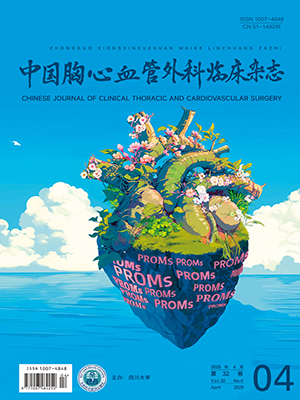| 1. |
Webb JG, Dvir D. Transcatheter aortic valve replacement for bioprosthetic aortic valve failure: The valve-in-valve procedure. Circulation, 2013, 127(25): 2542-2550.
|
| 2. |
Hon JK, Cheung A, Ye J, et al. Transatrial transcatheter tricuspid valve-in-valve implantation of balloon expandable bioprosthesis. Ann Thorac Surg, 2010, 90(5): 1696-1697.
|
| 3. |
McElhinney DB, Cabalka AK, Aboulhosn JA, et al. Transcatheter tricuspid valve-in-valve implantation for the treatment of dysfunctional surgical bioprosthetic valves: An international, multicenter registry study. Circulation, 2016, 133(16): 1582-1593.
|
| 4. |
张海波, 孟旭, 王胜洵, 等. 经导管二尖瓣生物瓣毁损的瓣中瓣治疗技术. 中华胸心血管外科杂志, 2019, 35(6): 331-333.
|
| 5. |
Cribier A, Eltchaninoff H, Bash A, et al. Percutaneous transcatheter implantation of an aortic valve prosthesis for calcific aortic stenosis: First human case description. Circulation, 2002, 106(24): 3006-3008.
|
| 6. |
Wenaweser P, Buellesfeld L, Gerckens U, et al. Percutaneous aortic valve replacement for severe aortic regurgitation in degenerated bioprosthesis: The first valve in valve procedure using the Corevalve revalving system. Catheter Cardiovasc Interv, 2007, 70(5): 760-764.
|
| 7. |
Dvir D, Webb JG, Bleiziffer S, et al. Transcatheter aortic valve implantation in failed bioprosthetic surgical valves. JAMA, 2014, 312(2): 162-170.
|
| 8. |
Ribeiro HB, Rodés-Cabau J, Blanke P, et al. Incidence, predictors, and clinical outcomes of coronary obstruction following transcatheter aortic valve replacement for degenerative bioprosthetic surgical valves: Insights from the VIVID registry. Eur Heart J, 2018, 39(8): 687-695.
|
| 9. |
Gurvitch R, Cheung A, Bedogni F, et al. Coronary obstruction following transcatheter aortic valve-in-valve implantation for failed surgical bioprostheses. Catheter Cardiovasc Interv, 2011, 77(3): 439-444.
|
| 10. |
Cheung A, Webb JG, Barbanti M, et al. 5-year experience with transcatheter transapical mitral valve-in-valve implantation for bioprosthetic valve dysfunction. J Am Coll Cardiol, 2013, 61(17): 1759-1766.
|
| 11. |
谢旭晶, 李力夫, 黄焕雷, 等. 经心尖二尖瓣瓣中瓣手术的早期结果. 中华胸心血管外科杂志, 2021, 37(10): 600-605.
|
| 12. |
Yoon SH, Bleiziffer S, Latib A, et al. Predictors of left ventricular outflow tract obstruction after transcatheter mitral valve replacement. JACC Cardiovasc Interv, 2019, 12(2): 182-193.
|
| 13. |
Urena M, Vahanian A, Brochet E, et al. Current indications for transcatheter mitral valve replacement using transcatheter aortic valves: Valve-in-valve, valve-in-ring, and valve-in-mitral annulus calcification. Circulation, 2021, 143(2): 178-196.
|
| 14. |
Blanke P, Naoum C, Dvir D, et al. Predicting LVOT obstruction in transcatheter mitral valve implantation: Concept of the neo-LVOT. JACC Cardiovasc Imaging, 2017, 10(4): 482-485.
|
| 15. |
Wang DD, Eng MH, Greenbaum AB, et al. Validating a prediction modeling tool for left ventricular outflow tract (LVOT) obstruction after transcatheter mitral valve replacement (TMVR). Catheter Cardiovasc Interv, 2018, 92(2): 379-387.
|
| 16. |
Silbiger JJ, Lee S, Christia P, et al. Mechanisms, pathophysiology, and diagnostic imaging of left ventricular outflow tract obstruction following mitral valve surgery and transcatheter mitral valve replacement. Echocardiography, 2019, 36(6): 1165-1172.
|
| 17. |
Pirelli L, Hong E, Steffen R, et al. Mitral valve-in-valve and valve-in-ring: Tips, tricks, and outcomes. Ann Cardiothorac Surg, 2021, 10(1): 96-112.
|
| 18. |
Conradi L, Silaschi M, Seiffert M, et al. Transcatheter valve-in-valve therapy using 6 different devices in 4 anatomic positions: Clinical outcomes and technical considerations. J Thorac Cardiovasc Surg, 2015, 150(6): 1557-1565.
|
| 19. |
Bapat V. Valve-in-valve apps: Why and how they were developed and how to use them. EuroIntervention, 2014, 10(Suppl U): U44-U51.
|
| 20. |
Gallo M, Sá MPBO, Doulamis IP, et al. Transcatheter valve-in-valve implantation for degenerated bioprosthetic aortic and mitral valves—An update on indications, techniques, and clinical results. Expert Rev Med Devices, 2021, 18(7): 597-608.
|
| 21. |
Lu Y, Yang Y, Wang W, et al. Transcatheter mitral valve-in-valve implantation with a new transcatheter heart valve for bioprosthetic degeneration. Front Cardiovasc Med, 2022, 8: 783507.
|




